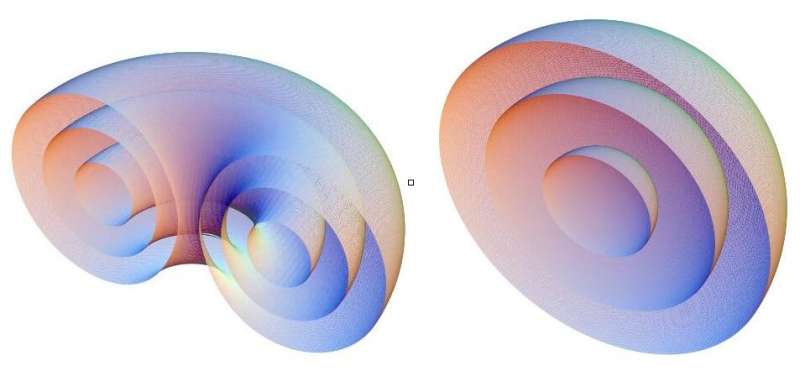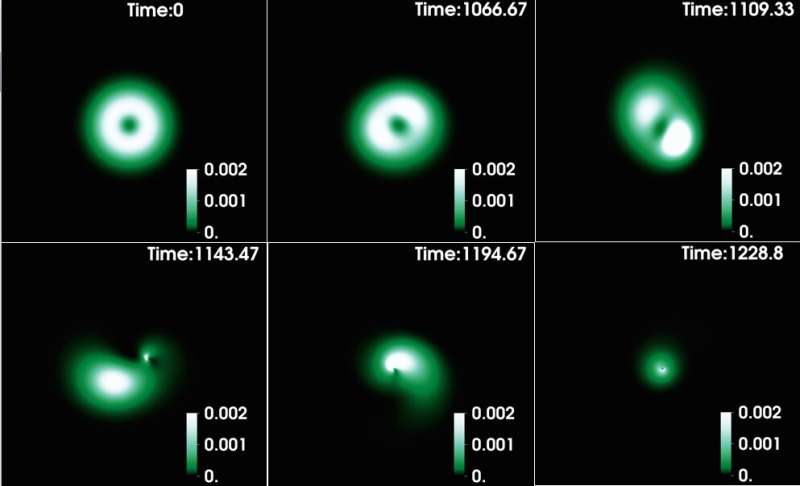December 12, 2019 feature
Study unveils new nonlinear dynamics of spinning bosonic stars

Although researchers have been studying dark matter and trying to observe it, its nature is a longstanding scientific mystery. The standard cosmological model suggests that approximately one-quarter of cosmological energy and matter is almost immune to electromagnetic interactions, thus the only way to observe it is to study its gravitational effects. However, the type of particles that make up dark matter is still a subject of debate.
A theory that received considerable attention over the past decade or so hypothesizes that dark matter is at least partly made up of ultra-light particles (i.e., much lighter than electrons, for instance). These particles differ from ordinary particles in several ways. For instance, their electrons, protons or neutrons, which constitute all the elements of the periodic table, are fermions. As a result, the particles have a half-integer spin, which is equal to one-half.
The ultra-light particles proposed as dark matter candidates are known as bosons. Bosons have an integer spin, which means it could be, for instance, zero or one. The key difference between fermions and bosons is that fermions follow the so-called Pauli exclusion principle, which states that two equal fermions cannot be in the same place, as they repel each other. On the other hand, bosons can cluster on top of each other, sometimes even forming macroscopic objects made up of an astronomical number of equal bosons.
Researchers at Universidade de Lisboa, Universitat de València and Universidade de Aveiro have recently carried out a fascinating study exploring the dynamics of spinning bosonic stars, which are stars formed from clusters of ultra-light bosons. Their paper, published in Physical Review Letters, provides valuable new insight into the dynamics of different types of spinning bosonic stars.
"If bosons are ultra-light, they can form objects with the mass of a star like the sun or even more massive," the researchers told Phys.org via email. "These stars, called bosonic stars, may be scattered throughout the universe, constituting part (or all) of dark matter. The question is whether these stars are stable."
Past studies have demonstrated that when stars are not spinning, they are stable. However, as the sun and all known stars and planets in our galaxy spin around their axis, other stars are expected to do so, as well.
"The lingering question was whether the rotating bosonic stars are stable," the researchers said. "Our paper answers this question and the answer is richer than anticipated."
Overall, bosonic stars can be quite compact, which means that their mass is contained within a small space. Because of this particular quality, these stars are best described using Albert Einstein's general relativity theory rather than Newtonian gravity.

In their study, the researchers at Universidade de Lisboa, Universitat de València and Universidade de Aveiro performed a series of numerical relativity simulations using a free platform called the Einstein Toolkit. Though these simulations, they numerically solved the equations of general relativity, which describe the behavior of gravity, as well as the corresponding evolution equations for the matter that composes bosonic stars.
"Performing numerical evolutions requires correct initial data that describes how the gravitational and matter fields are at some initial time," the researchers explained. "We thus considered two scenarios. In the first scenario, a large cloud of the corresponding bosonic matter is about to collapse to (potentially) form a spinning star. In the second scenario, we start with a star in equilibrium to assess if it is robust against perturbations, or, on the other hand, if it is unstable."
Spinning bosonic stars can have different morphologies. If the particle they are made of has a spin equal to zero, they are called scalar stars. On the other hand, if this particle has a spin equal to one, they are referred to as vector stars.
Einstein's theory of general relativity describes bosonic stars when they are compact, predicting that rotating scalar stars have a donut-like shape (i.e., torus). The same theory predicts that vector stars have a shape that is more common for rotating, more or less spherical stars, but slightly flattened at the poles (i.e., spheroidal), like that of planet Earth.
Interestingly, the numerical simulations and analyses carried out by the researchers show that when toroidal stars are slightly disturbed, they eventually break into pieces. Some of these pieces are then pushed away, taking the angular momentum of the star.
"The end result is a total fission of the original star, or in some cases, the relaxation of the original star to a lighter, non-rotating star, or yet, in other cases, the full collapse of the star into a black hole," the researchers said. "In the case of spheroidal stars, on the other hand, they are robust to perturbations, like the normal stars known in the universe."
The researchers gathered interesting findings that could shed some light on the dynamics of bosonic stars. Perhaps even more remarkably, however, the study suggests that the detection of rotating ultra-light dark matter stars could help to better understand the nature of particles that make up dark matter, particularly their spin. In the future, the researchers plan to carry out further research focusing on the instability of spinning scalar bosonic stars, considering a more complex type of particle that can interact with itself.
"These self-interactions are suggested by some models of dark matter and high-energy physics," the researchers explained. "The question that we are interested in exploring is: can they quench the instability? Moreover, we would like to assess if the instability is intrinsically related to the morphology. That is, if toroidal stars are always unstable. To do this, we are analyzing some more complicated models of spinning vector stars that can take the toroidal shape to test if they are also unstable."
More information: N. Sanchis-Gual et al. Nonlinear Dynamics of Spinning Bosonic Stars: Formation and Stability, Physical Review Letters (2019). DOI: 10.1103/PhysRevLett.123.221101
Journal information: Physical Review Letters
© 2019 Science X Network



















